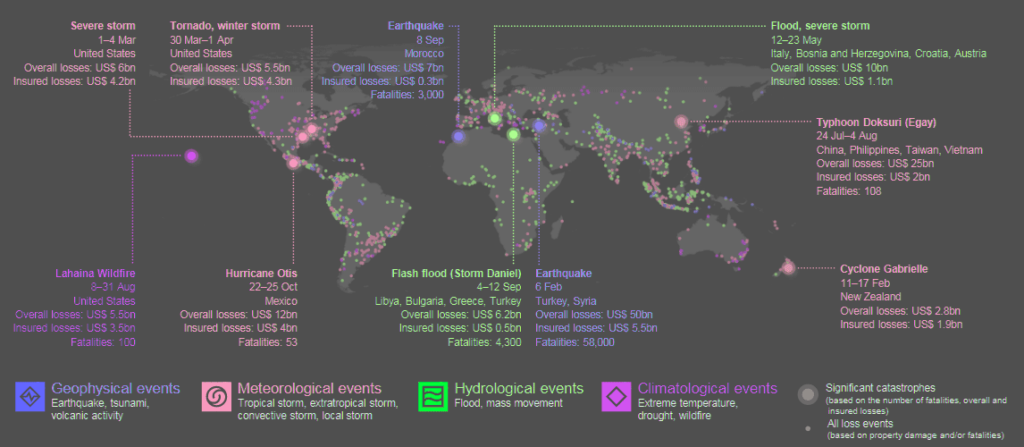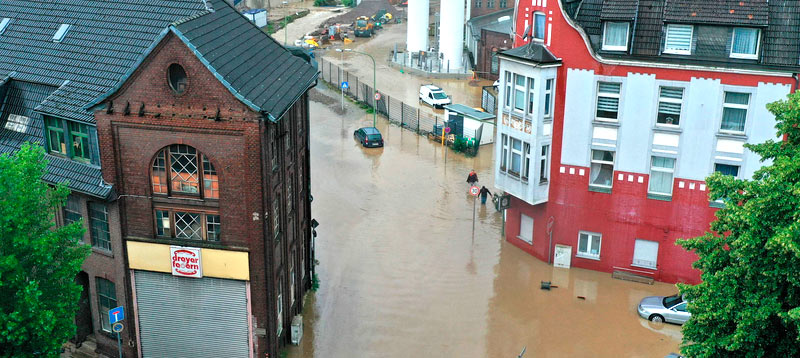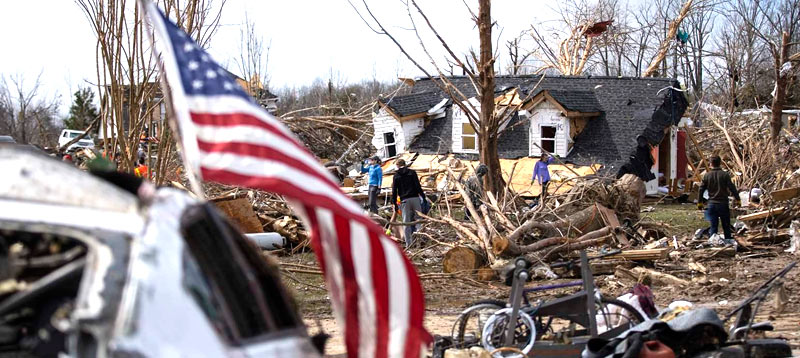The year 2023 was once again characterised by extremely high insured losses from natural disasters, despite the fact that there were no extreme individual losses. This underlines the important role that insurance plays in cushioning the consequences of natural disasters, according to Munich Re report.
Comprehensive data and in-depth knowledge of changes in risks remain key factors when designing covers to protect people against natural disasters. A further important aspect is prevention.
The number of victims from the devastating earthquakes this year is a wake-up call to ensure better protection for people by adapting construction methods.
- Overall losses from natural disasters in 2023: US$ 250bn; more than 74,000 fatalities
- Insured global losses of US$ 95bn close to five-year average (US$ 105bn) and above the ten-year average (US$ 90bn), according to Global Natural Disasters Figures
- Earthquake in Turkey and Syria was the year’s most devastating humanitarian disaster
- Thunderstorms in North America and Europe more destructive than ever before: overall losses of US$ 76bn; insured losses US$ 58bn
- 2023 was the hottest year ever, with a large number of regional records broken
2023 natural disasters in figures

Worldwide, natural disasters in 2023 resulted in losses of around US$ 250bn (previous year US$ 250bn), with insured losses of US$ 95bn (previous year US$ 125bn).
Overall losses tally with the five-year average, while insured losses were slightly below the average figure of US$ 105bn.
Unlike in previous years, there were no mega-disasters in industrialised countries that drove losses up (such as Hurricane Ian in 2022, which caused overall losses of US$ 100bn and insured losses of US$ 60bn) (see Main Factors of the Increase in Insurance Losses from Natural Disasters).
Instead, the loss statistics were characterised by the large number of severe regional storms. Such high thunderstorm losses have never been recorded before in the USA or in Europe: assets worth around US$ 66bn were destroyed in North America, of which US$ 50bn was insured, while in Europe the figure was US$ 10bn (€9.1bn), of which US$ 8bn (€7.3bn) was insured.
Natural catastrophes loss events

According to Global Natural Catastrophe Review, a large body of scientific research indicates that climate change favours severe weather with heavy hailstorms. Similarly, loss statistics from thunderstorms in North America and other regions are trending upwards.
The number of deaths caused by natural disasters rose to 74,000 in 2023, well above the annual average of the last five years (10,000). After years of relative calm, a series of devastating earthquakes led to humanitarian disasters.
Around 63,000 people (85% of the year’s total fatalities) lost their lives as a result of such geophysical hazards in 2023 – more than at any time since 2010. In contrast, economic losses from natural disasters were dominated by severe storms: 76% of overall losses were weather-related, while 24% had geophysical causes.
Global temperature set to break record

Weather disasters were exacerbated by extremely high temperatures. Worldwide, average temperatures to November were roughly 1.3°C above those in pre-industrial times (1850–1900). It soon became clear that 2023 would become the hottest year since temperature measurements began, which means that the last ten years are the hottest on record.
The El Niño phenomenon, a natural climate oscillation in the North Pacific with effects on extreme weather in many regions of the world, played a role in the temperatures.
However, researchers attribute the trend towards warmer global temperatures mainly to climate change, with natural fluctuations playing a subordinate role.
Seasonal temperature records tumbled one after another in 2023. Spring temperatures of over 40°C were recorded in southwest Europe (April) and in Argentina (September), temperatures of more than 50°C in northwest China, and night-time temperatures in excess of 32°C in the US state of Arizona in July: according to studies, there are clear connections to climate change.
In many regions, major wildfires resulted from heatwaves and drought. In Canada, fires raged for several weeks, destroying 18.5 million hectares of forest, more than ever before.
The fires did not reach any major cities or industrial facilities, meaning that Canada avoided another wildfire disaster like the one in Fort McMurray in 2016 (damage at the time: US$ 4.1bn, of which US$ 2.9bn was insured).
“The warming of the earth that has been accelerating for some years is intensifying the extreme weather in many regions, leading to increasing loss potentials. More water evaporates at higher temperatures, and additional moisture in the atmosphere provides further energy for severe storms.
Society and industry need to adapt to the changing risks – otherwise loss burdens will inevitably increase. Analysing risks and the changes to them is hardwired into Munich Re’s DNA. That is what enables us to consistently offer insurance covers against natural disasters – and even to expand them.
This allows us to cushion a portion of the losses and alleviate some of the hardship caused”, explains Ernst Rauch, Chief Climate Scientist.
The year’s costliest natural disaster events

The series of earthquakes in Turkey and Syria in February was the year’s most destructive natural disaster. The most severe, a 7.8-magnitude tremor, was the strongest quake in Turkey for decades. Some 58,000 people were killed, countless buildings collapsed, and there was significant damage to infrastructure (see Top 10 Global Economic & Insured Loss Events).
With overall losses of around US$ 50bn, it was also the year’s costliest natural disaster. Despite the fact that earthquake insurance is mandatory for residential buildings in Turkey (Turkish Catastrophe Insurance Pool, TCIP), insured losses came to just US$ 5.5bn.
In terms of overall losses, the second-costliest natural disaster was Typhoon Doksuri. In July, the storm brushed the coastline of the Philippines before making landfall at Jinjiang in Fujian province on the Chinese mainland with wind speeds of around 180 km/h.
Doksuri was accompanied by extremely heavy rainfall that triggered destructive flooding. In parts of China, 600 mm of rain fell in one day, the heaviest daily rainfall amount ever recorded in the country. Overall losses came to around US$ 25bn, of which only roughly US$ 2bn was insured – an example of the large insurance gap for natural disasters that persists in China.
The rapid intensification of Hurricane Otis on the west coast of Mexico in October was another exceptional event: within twenty-four hours, it developed from a weak tropical storm to a highest-category hurricane. It made landfall directly in the holiday resort of Acapulco and devastated the city.
With wind speeds of up to 265 km/h, it was the most severe storm ever to hit Mexico’s Pacific coast. Overall losses are estimated at US$ 12bn, and insured losses at around US$ 4bn due to the high concentration of hotels in the city. It was the year’s third-costliest loss in terms of overall losses.
Doksuri and Otis fall into the pattern that scientists expect as a result of climate change, namely a shift towards an increased number of intense storms and storms with extreme rainfall. Experts also attribute the more frequently observed rapid intensification of tropical storms to climate change.
Natural disasters in 2023

TOP 5 largest natural disasters in 2023

The three largest natural disasters per continent in 2023

Geographical overview

North America
North America once again recorded the highest losses worldwide, although this year its share of global losses was smaller than usual (40%; five-year average 57%). Natural disasters destroyed assets worth US$ 100bn, of which around US$ 67bn was insured.
In spite of the large number of severe thunderstorms, the loss amount for all natural disasters was less than that of the previous year (overall losses US$ 160bn, with US$ 100bn insured).
The hurricane season in the USA was comparatively mild. Although Hurricane Idalia, one of the most severe storms of the year, hit the US mainland, the affected region in northwest Florida is sparsely populated.
However, the hurricane season in the North Atlantic was more active than average with 20 named storms, including seven hurricanes, three of which were major hurricanes, as high water temperatures offset the dampening effect of El Niño. However, most of the storms did not reach land but raged over the sea.

Two thunderstorm outbreaks in the USA in March (Midwest) and in June (Texas) numbered among the year’s costliest natural disasters worldwide in terms of insured losses.
These thunderstorm series alone caused combined overall losses of US$ 17bn, of which around US$ 12bn was insured.
A devastating fire fanned by strong winds swept across Hawaii in August, destroying large parts of the coastal town of Lahaina on the island of Maui. Like the Marshall Fire in Colorado in December 2021, this event shows that grassfires in high wind conditions can spread rapidly and cause significant losses. Overall losses are estimated at US$ 5.5bn, of which roughly US$ 3.5bn was insured.
Europe
Losses from natural disasters in Europe came to US$ 83bn (€77bn), largely due to the earthquake in Turkey. Insured losses came to around US$ 19bn (€18bn). In particular, storms in the Alpine region and in the Mediterranean area contributed to the record thunderstorm losses.
In July and August, hailstones measuring up to 19 cm in diameter caused billions of dollars of losses in northern Italy and several other regions.
They were the result of the high prevailing temperatures and the accompanying risk of severe storms as a result of increased evaporation. There is scientific evidence that climate change is promoting the development of conditions like these.

Torrential rainfall in countries along the Adriatic coast caused widespread flooding in May and August. A low-pressure system at the start of September triggered severe flooding, particularly in Greece, and then intensified over the Mediterranean to a cyclone, Medicane Daniel. Losses from these events in Europe amounted to US$ 17bn, of which US$ 2bn was insured.
In December, sustained rainfall caused heavy flooding in many parts of northern Germany. As the floods were still ongoing in early 2024, the volume of losses could not be accurately estimated at the time of writing.
Asia-Pacific and Africa
In the Asia-Pacific and Africa region, the overall losses in 2023 of US$ 64bn were slightly lower than in the previous year (US$ 66bn). Approximately US$ 8bn of this amount was insured (previous year: US$ 11bn). Japan, a country highly exposed to natural hazards, was largely spared major damage in 2023.
While Typhoon Doksuri was the year’s costliest disaster in terms of overall losses, two major catastrophes in New Zealand together accounted for the highest insured losses in Asia-Pacific (around US$ 4bn).
In early February, there were massive floods in and around Auckland, New Zealand’s biggest city, causing insured losses of nearly US$ 2bn and overall losses of US$ 2.9bn. In mid-February, Cyclone Gabrielle hit New Zealand’s North Island and Norfolk Island, resulting in huge damage. Losses from the cyclone were at a similar level to those from the floods.
In Africa, Medicane Daniel made landfall in Libya in September, and was accompanied by torrential rainfall. Dams in the city of Derna collapsed. More than 4,000 people lost their lives in the ensuing floods.
Also in September, around 3,000 people were killed in a 6.8-magnitude earthquake in Morocco. It was the strongest earthquake in Morocco for well over 100 years.
The destructive power of the quake produced overall losses of some US$ 7bn. Very little was protected, with insured losses totalling around US$ 0.3bn.
At the start of the year, Cyclone Freddy triggered a humanitarian disaster in southeast Africa. Freddy formed off the Australian coast, before crossing the entire southern Indian Ocean, covering a distance of more than 8,000 kilometres. It now holds the record for the longest cyclone ever registered (five weeks).
It made landfall on the island of Madagascar and then meandered back and forth between Madagascar and Mozambique. As a result, Mozambique was impacted twice over by the tropical cyclone. More than 1,400 people were killed in Mozambique and neighbouring countries.
In the northeast of Australia, severe flooding occurred in mid-December as a result of tropical storm Jasper in the state of Queensland. According to media reports, there was more than 800 mm of rain in just one day. This is roughly equivalent to the average annual rainfall in Germany. Numerous rivers burst their banks. It is still too early to reliably quantify the damage.
As in other regions, ENSO conditions influence weather extremes in Asia, in addition to climate change. The El Niño ENSO expression peaked at the end of the year and will most likely subside by mid-year. Australia can therefore hope for a mild cyclone season overall, lasting until the end of April. In contrast, the risk of forest fires is likely to be increased as the lush vegetation of recent months begins to dry out, increasing flammability. If El Niño turns into its counterpart, La Niña, in the second half of 2024, the risk of flooding for eastern Australia could increase.
The outlook for the typhoon season in the northwest Pacific remains unclear due to the uncertainty of ENSO development in the second half of the year. In the event of a La Niña phase, typhoon activity in the northwest Pacific could be below average. However, more storms could hit the Philippines, as storms under La Niña conditions tend to move westwards rather than northwards.
………………….
QUOTES: Thomas Blunck – Member of the Board of Management Munich Re, Ernst Rauch – Chief Climate and Geo Scientist at Munich Re
Edited by Oleg Parashchak – CEO Finance Media, Editor-in-Chief Beinsure Media








